Adjustable Sound Absorber of Multiple Parallel-Connection Helmholtz Resonators with Tunable Apertures Prepared by Low-Force Stereolithography of Photopolymer Resin
Abstract
:1. Introduction
2. Materials and Methods
2.1. Structural Design
2.2. Theoretical Modeling
2.3. Influence of the Tunable Aperture
- (1)
- The length of the aperture for each Helmholtz resonator in one metamaterial cell was labelled as li (i = 1,2, …,9), and li decreased along with an increase in the serial number of the Helmholtz resonator in the metamaterial cell, which meant that l1 > l2 > l3 > l4 > l5 > l6 > l7 > l8 > l9.
- (2)
- The target frequency range [fmin, fmax] was divided into 9 sections, and l1 was responsible for absorbing the noise with the lowest section and l9 corresponded to the absorption of the noise with the highest section.
- (3)
- The optimization objective was a maximum average sound absorption coefficient α(f) in the target frequency range.
- (4)
- The optimization would be stopped if the conditions of the average sound absorption coefficient were not improved, or if the improvement extent was smaller than 1% in the latest 20 measurements.
2.4. Analysis of the Sound Absorption Mechanism of TA–MPCHR
2.5. Result and Discussion
3. Conclusions
Author Contributions
Funding
Institutional Review Board Statement
Informed Consent Statement
Data Availability Statement
Conflicts of Interest
References
- Liang, M.; Wu, H.; Liu, J.; Shen, Y.; Wu, G. Improved sound absorption performance of synthetic fiber materials for industrial noise reduction: A review. J. Porous Mater. 2022, 29, 869–892. [Google Scholar] [CrossRef]
- Hong, J.; Kang, H.; Hong, T.; Park, H.S.; Lee, D.E. Construction noise rating based on legal and health impacts. Automat. Constr. 2022, 134, 104053. [Google Scholar] [CrossRef]
- Wing, S.E.; Larson, T.V.; Hudda, N.; Boonyarattaphan, S.; Del Rosario, I.; Fruin, S.; Ritz, B. Aircraft noise and vehicle traffic–related air pollution interact to affect preterm birth risk in Los Angeles, California. Sci. Total Environ. 2022, 829, 154678. [Google Scholar] [CrossRef] [PubMed]
- Dzhambov, A.; Tilov, B.; Markevych, I.; Dimitrova, D. Residential road traffic noise and general mental health in youth: The role of noise annoyance, neighborhood restorative quality, physical activity, and social cohesion as potential mediators. Environ. Int. 2017, 109, 1–9. [Google Scholar] [CrossRef]
- Huang, H.Y.; Cao, E.R.; Zhao, M.Y.; Alamri, S.; Li, B. Spider Web–Inspired Lightweight Membrane–Type Acoustic Metamaterials for Broadband Low–Frequency Sound Isolation. Polymers 2021, 13, 1146. [Google Scholar] [CrossRef]
- Heo, H.; Sofield, M.; Ju, J.; Neogi, A. Acoustic Metasurface–Aided Broadband Noise Reduction in Automobile Induced by Tire–Pavement Interaction. Materials 2021, 14, 4262. [Google Scholar] [CrossRef]
- Gao, H.Q.; Yan, Q.; Liu, X.S.; Zhang, Y.; Sun, Y.T.; Ding, Q.; Wang, L.; Xu, J.X.; Yan, H. Low–Frequency Bandgaps of the Lightweight Single–Phase Acoustic Metamaterials with Locally Resonant Archimedean Spirals. Materials 2022, 15, 373. [Google Scholar] [CrossRef]
- Duan, H.Q.; Yang, F.; Shen, X.M.; Yin, Q.; Wang, E.S.; Zhang, X.N.; Yang, X.C.; Shen, C.; Peng, W.Q. Acoustic Metamaterials for Low–Frequency Noise Reduction Based on Parallel Connection of Multiple Spiral Chambers. Materials 2022, 15, 3882. [Google Scholar] [CrossRef]
- Liu, C.K.; Ma, C.; Li, X.H.; Luo, J.; Fang, N.X.; Lai, Y. Wide–Angle Broadband Nonreflecting Acoustic Metamaterial Fence. Phys. Rev. Appl. 2020, 13, 054012. [Google Scholar] [CrossRef]
- Setyowati, E.; Hardiman, G.; Purwanto, P. Tailoring Acoustic Performances of Resin Reinforced Biomass Fiber–Based Panel with Single and Multiple Tailed Cavity Inclusions for Interior Work. Fibers 2019, 7, 85. [Google Scholar] [CrossRef]
- Liao, Y.; Huang, H.; Chang, G.; Luo, D.; Xu, C.; Wu, Y.; Tang, J. Research on Low–Frequency Noise Control of Automobiles Based on Acoustic Metamaterial. Materials 2022, 15, 3261. [Google Scholar] [CrossRef] [PubMed]
- Xing, T.; Gai, X.L.; Zhao, J.J.; Li, X.H.; Cai, Z.N.; Guan, X.W.; Wang, F. Low frequency sound absorption of adjustable membrane–type acoustic metamaterials. Appl. Acoust. 2022, 188, 108586. [Google Scholar] [CrossRef]
- Duan, H.Q.; Shen, X.M.; Wang, E.S.; Yang, F.; Zhang, X.N.; Yin, Q. Acoustic multi–layer Helmholtz resonance metamaterials with multiple adjustable absorption peaks. Appl. Phys. Lett. 2021, 118, 241904. [Google Scholar] [CrossRef]
- Zhai, S.L.; Wang, Y.B.; Zhao, X.P. A kind of tunable acoustic metamaterial for low frequency absorption. Acta Phys. Sin. 2019, 68, 034301. [Google Scholar] [CrossRef]
- Xu, Z.X.; Meng, H.Y.; Chen, A.; Yang, J.; Liang, B.; Cheng, J.C. Tunable low–frequency and broadband acoustic metamaterial absorber. J. Appl. Phys. 2021, 129, 094502. [Google Scholar] [CrossRef]
- Jiang, P.T.; Jiang, T.X.; He, Q.B. Origami–based adjustable sound–absorbing metamaterial. Smart Mater. Struct. 2021, 30, 057002. [Google Scholar] [CrossRef]
- Zhu, X.F.; Lau, S.K.; Lu, Z.B.; Jeon, W. Broadband low–frequency sound absorption by periodic metamaterial resonators embedded in a porous layer. J. Sound Vib. 2019, 461, 114922. [Google Scholar] [CrossRef]
- Gao, N.S.; Zhang, Z.C.; Tang, L.L.; Hou, H.; Chen, K.A. Optimal design of broadband quasi–perfect sound absorption of composite hybrid porous metamaterial using TLBO algorithm. Appl. Acoust. 2021, 183, 108296. [Google Scholar] [CrossRef]
- Shao, H.B.; He, H.; Chen, Y.; Tan, X.; Chen, G.P. A tunable metamaterial muffler with a membrane structure based on Helmholtz cavities. Appl. Acoust. 2020, 157, 107022. [Google Scholar] [CrossRef]
- Pei, D.L.; Yang, T.; Chen, M.; Jiang, H. Underwater acoustic metamaterial based on double Dirac cone characteristics in rectangular phononic crystals. Chin. Phys. B. 2020, 28, 124301. [Google Scholar] [CrossRef]
- Lu, Z.B.; Yu, X.; Lau, S.K.; Khoo, B.C.; Cui, F.S. Membrane–type acoustic metamaterial with eccentric masses for broadband sound isolation. Appl. Acoust. 2020, 157, 107003. [Google Scholar] [CrossRef]
- Ren, S.W.; Van Belle, L.; Claeys, C.; Xin, F.X.; Lu, T.J.; Deckers, E.; Desmet, W. Improvement of the sound absorption of flexible micro–perforated panels by local resonances. Mech. Syst. Signal Process. 2019, 117, 138–156. [Google Scholar] [CrossRef]
- Liu, Y.Y.; Ren, S.W.; Sun, W.; Lei, Y.; Wang, H.T.; Zeng, X.Y. Broadband low–frequency sound absorbing metastructures based on impedance matching coiled–up cavity. Appl. Phys. Lett. 2021, 119, 101901. [Google Scholar] [CrossRef]
- Zhang, T.; Bok, E.; Tomoda, M.; Matsuda, O.; Guo, J.Z.; Liu, X.J.; Wright, O.B. Compact acoustic metamaterial based on the 3D Mie resonance of a maze ball with an octahedral structure. Appl. Phys. Lett. 2022, 120, 161701. [Google Scholar] [CrossRef]
- Xiang, X.; Tian, H.X.; Huang, Y.Z.; Wu, X.X.; Wen, W.J. Manually tunable ventilated metamaterial absorbers. Appl. Phys. Lett. 2021, 118, 053504. [Google Scholar] [CrossRef]
- Gu, L.M.; Zhao, C.Y.; Wang, K.Q.; Li, S.L.; Wang, X.L.; Huang, Z.Y. Asymmetric sound absorption achieved by double–layer piezoelectric metamaterials with tunable shunt circuit. Appl. Phys. Lett. 2021, 119, 131903. [Google Scholar] [CrossRef]
- Qu, S.; Gao, N.; Tinel, A.; Morvan, B.; Romero-García, V.; Groby, J.P.; Sheng, P. Underwater metamaterial absorber with impedance–matched composite. Sci. Adv. 2022, 8, 4206. [Google Scholar] [CrossRef]
- Yang, M.; Sheng, P. Sound Absorption Structures: From Porous Media to Acoustic Metamaterials. Annu. Rev. Mater. Res. 2017, 47, 83–114. [Google Scholar] [CrossRef]
- Wang, E.S.; Yang, F.; Shen, X.M.; Duan, H.Q.; Zhang, X.N.; Yin, Q.; Peng, W.Q.; Yang, X.C.; Yang, L. Development and Optimization of Broadband Acoustic Metamaterial Absorber Based on Parallel–Connection Square Helmholtz Resonators. Materials 2022, 15, 3417. [Google Scholar] [CrossRef]
- Yang, X.C.; Yang, F.; Shen, X.M.; Wang, E.S.; Zhang, X.N.; Shen, C.; Peng, W.Q. Development of Adjustable Parallel Helmholtz Acoustic Metamaterial for Broad Low–Frequency Sound Absorption Band. Materials 2022, 15, 5938. [Google Scholar] [CrossRef]
- Yang, F.; Wang, E.S.; Shen, X.M.; Zhang, X.N.; Yin, Q.; Wang, X.Q.; Yang, X.C.; Shen, C.; Peng, W.Q. Optimal Design of Acoustic Metamaterial of Multiple Parallel Hexagonal Helmholtz Resonators by Combination of Finite Element Simulation and Cuckoo Search Algorithm. Materials 2022, 15, 6450. [Google Scholar] [CrossRef] [PubMed]
- Chiu, M.C. Numerical assessment for a broadband and tuned noise using hybrid mufflers and a simulated annealing method. J. Sound Vib. 2013, 332, 2923–2940. [Google Scholar] [CrossRef]
- Jimenez, N.; Romero–Garcia, V.; Pagneux, V.; Groby, J.P. Rainbow–trapping absorbers: Broadband, perfect and asymmetric sound absorption by subwavelength panels for transmission problems. Sci. Rep. 2017, 7, 13595. [Google Scholar] [CrossRef] [Green Version]
- Min, H.Q.; Guo, W.C. Sound absorbers with a micro–perforated panel backed by an array of parallel–arranged sub–cavities at different depths. Appl. Acoust. 2019, 149, 123–128. [Google Scholar] [CrossRef]
- Yang, M.; Chen, S.Y.; Fuab, C.X.; Sheng, P. Optimal sound–absorbing structures. Mater. Horiz. 2017, 4, 673–680. [Google Scholar] [CrossRef] [Green Version]
- Romero-García, V.; Theocharis, G.; Richoux, O.; Pagneux, V. Use of complex frequency plane to design broadband and sub-wavelength absorbers. J. Acoust. Soc. Am. 2016, 139, 3395. [Google Scholar] [CrossRef] [Green Version]
- Romero-García, V.; Theocharis, G.; Richoux, O.; Merkel, A.; Tournat, V.; Pagneux, V. Perfect and broadband acoustic absorption by critically coupled sub-wavelength resonators. Sci Rep. 2016, 6, 19519. [Google Scholar] [CrossRef]
- Herrero-Durá, I.; Cebrecos, A.; Picó, R.; Romero-García, V.; García-Raffi, L.M.; Sánchez-Morcillo, V.J. Sound Absorption and Diffusion by 2D Arrays of Helmholtz Resonators. Appl. Sci. 2020, 10, 1690. [Google Scholar] [CrossRef]


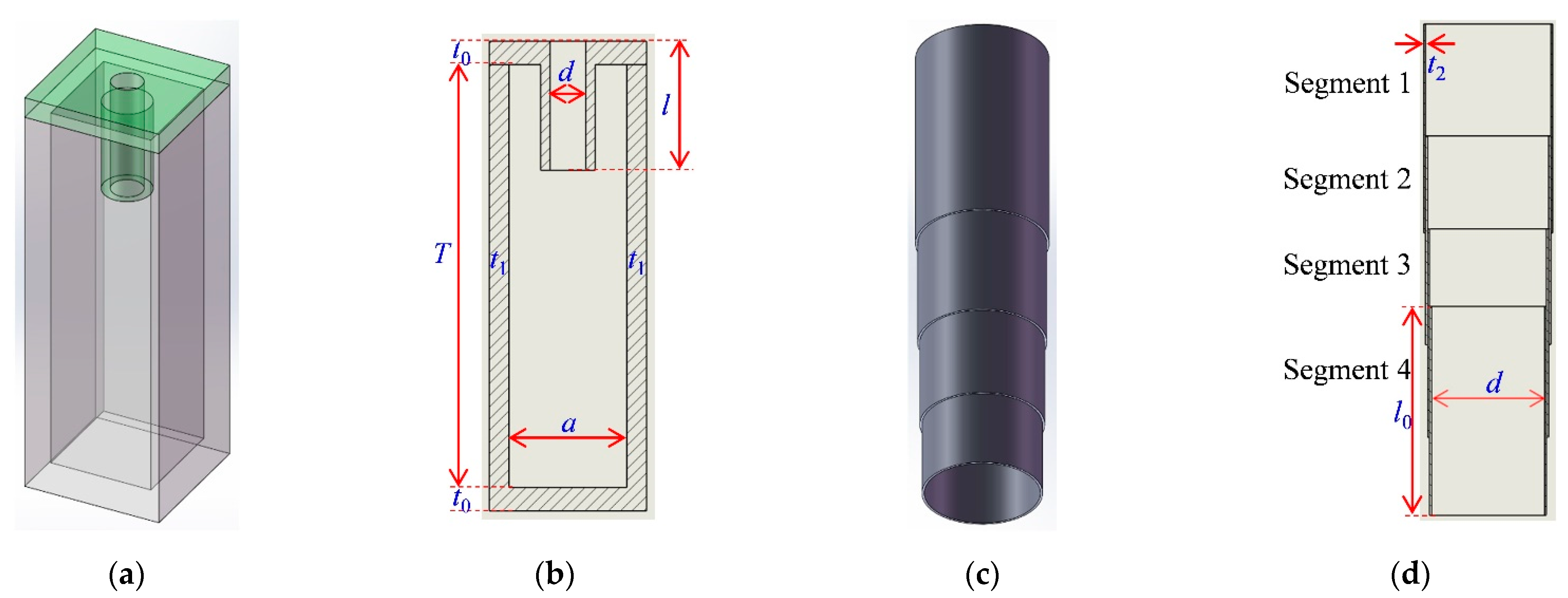
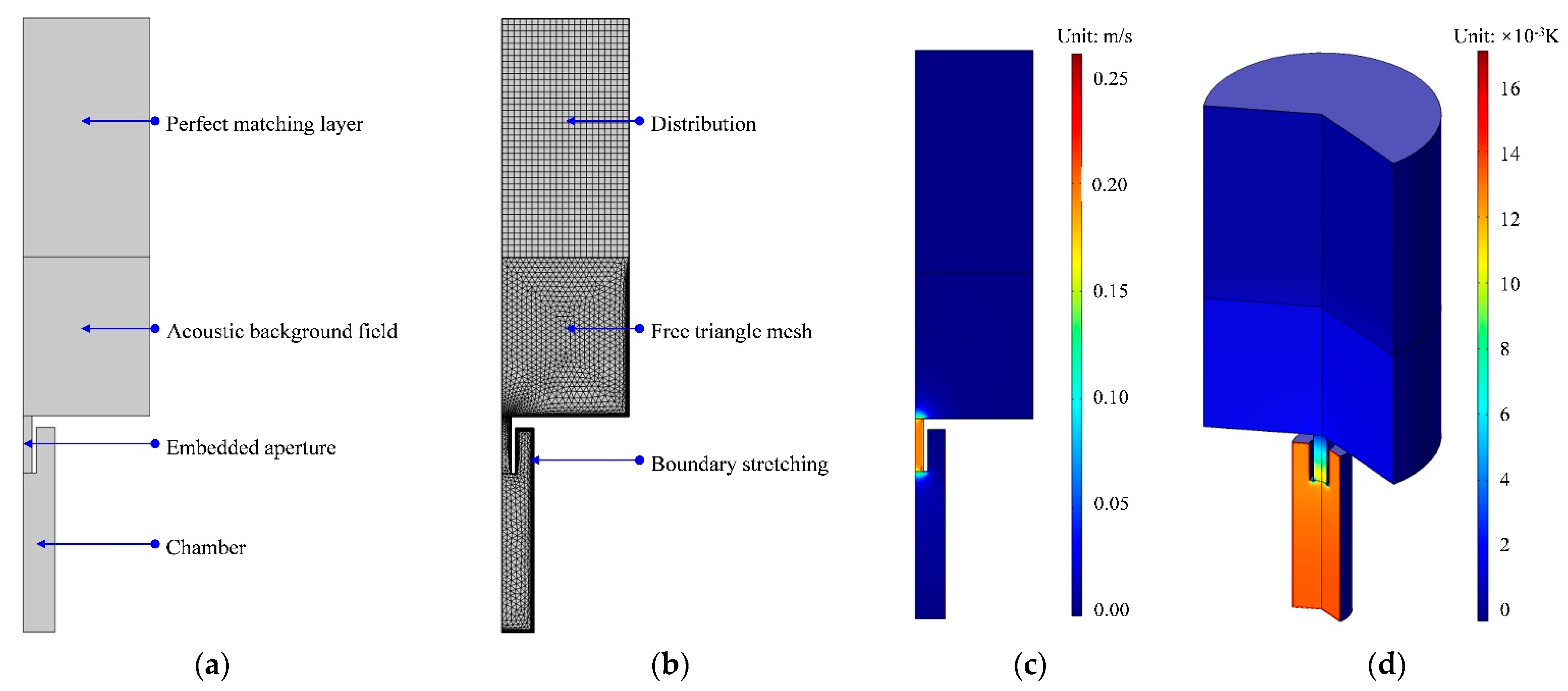
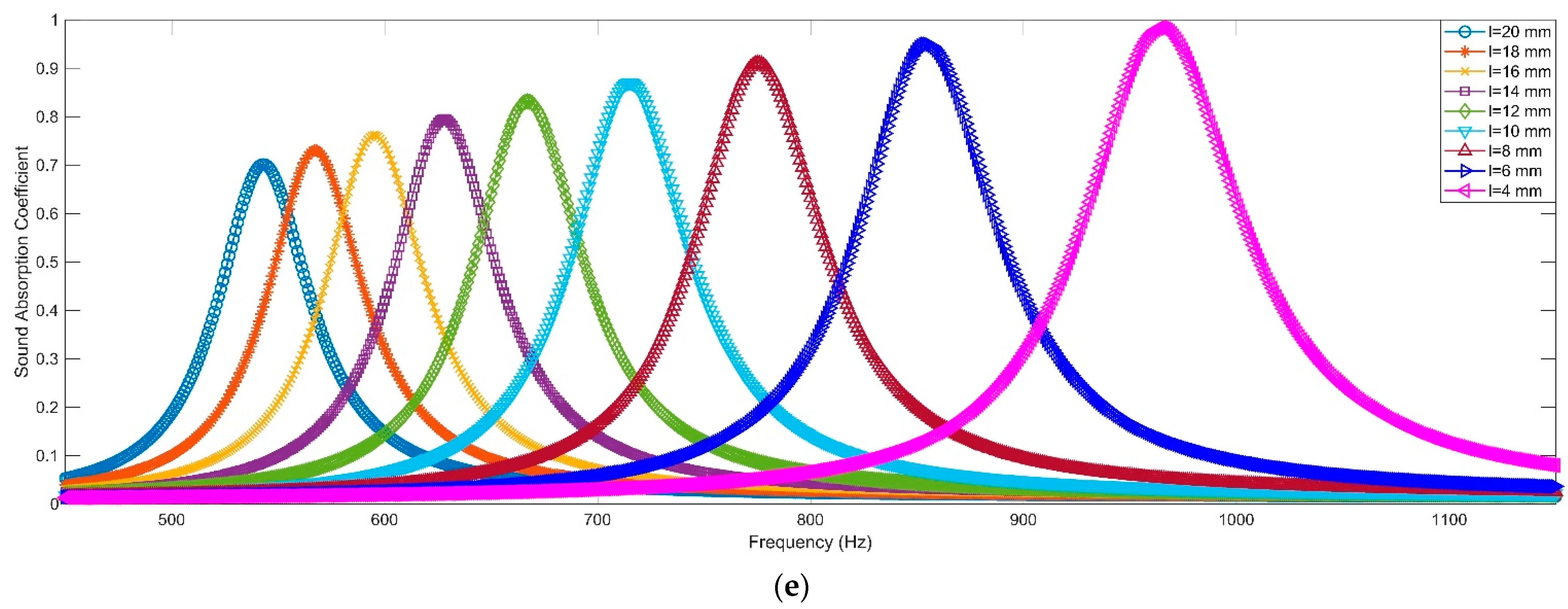
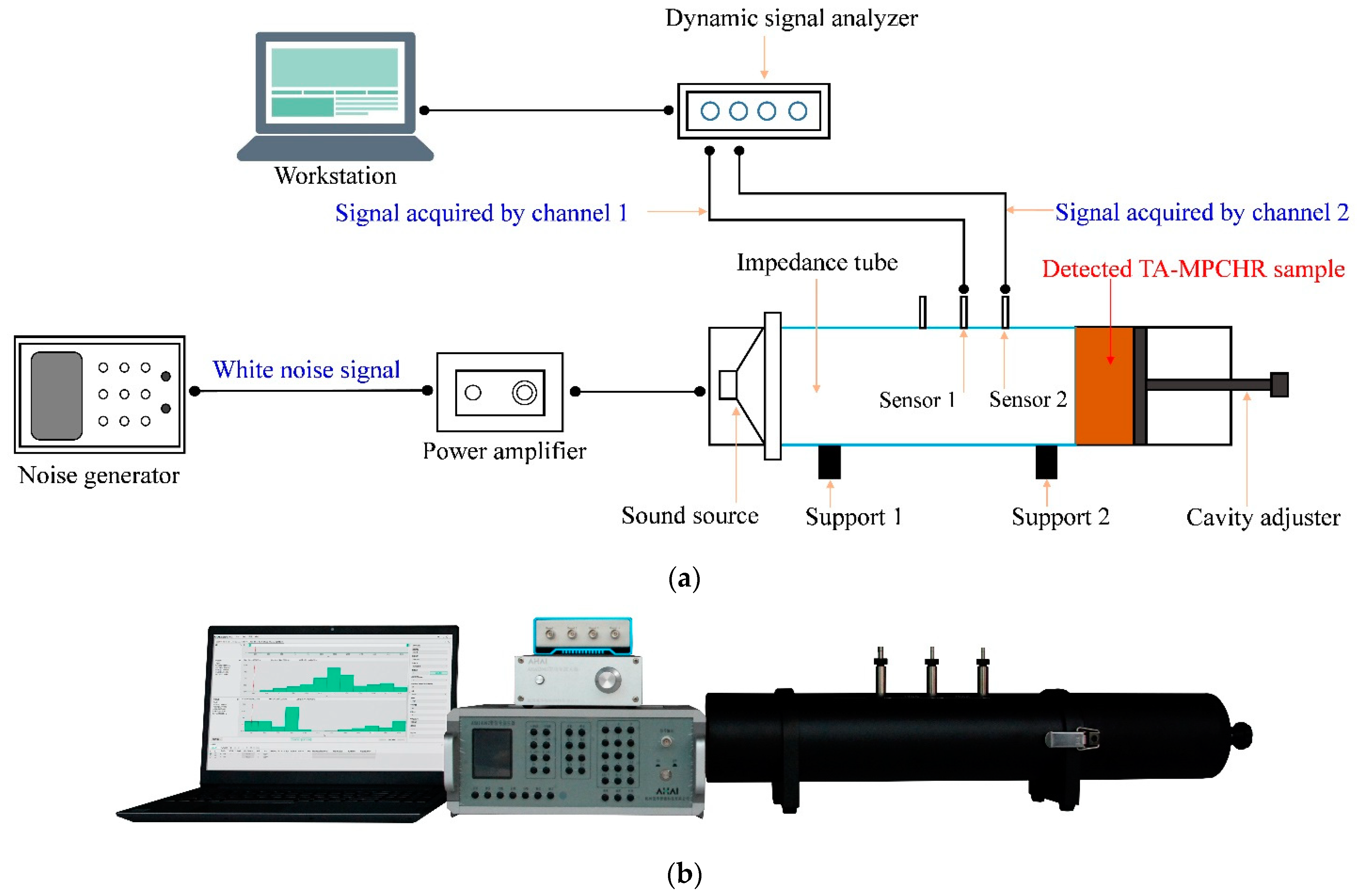
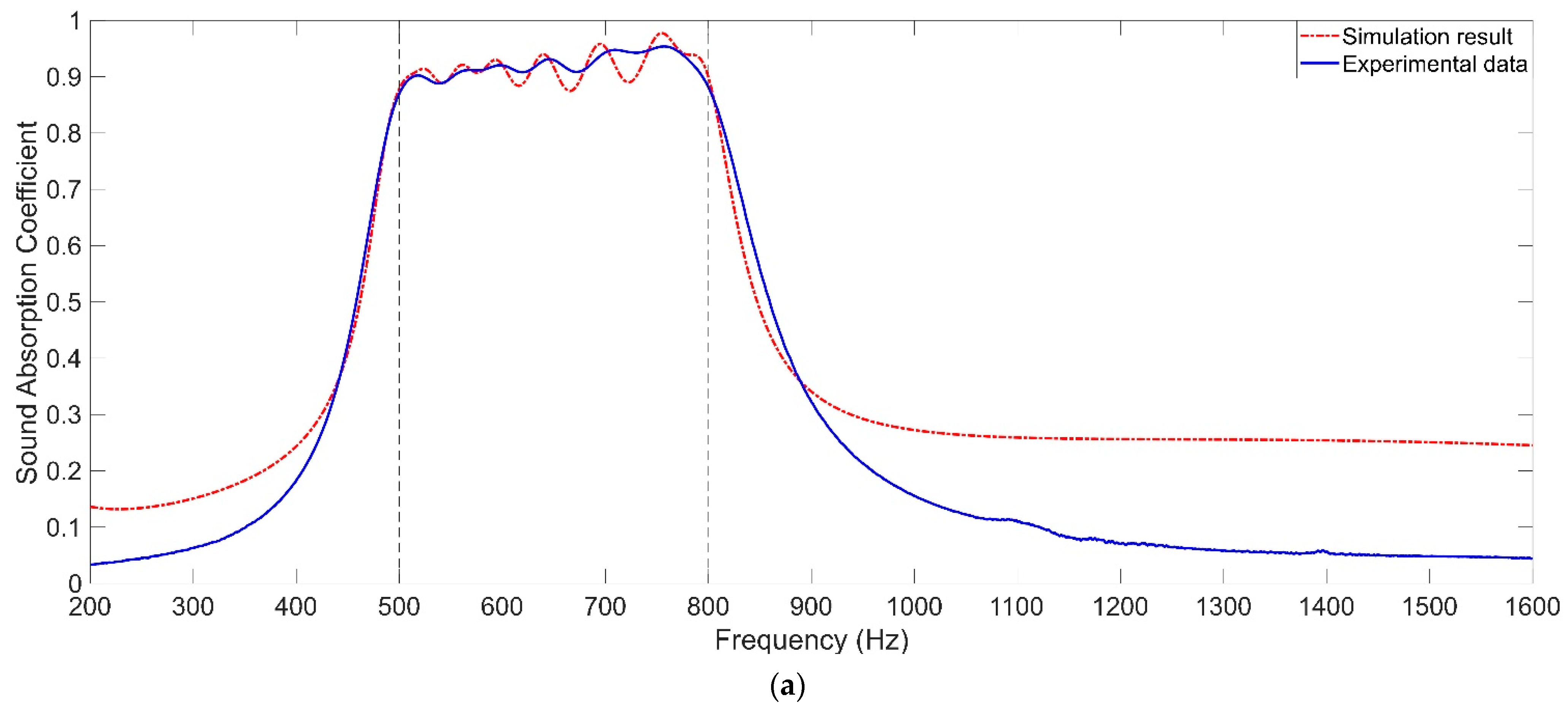
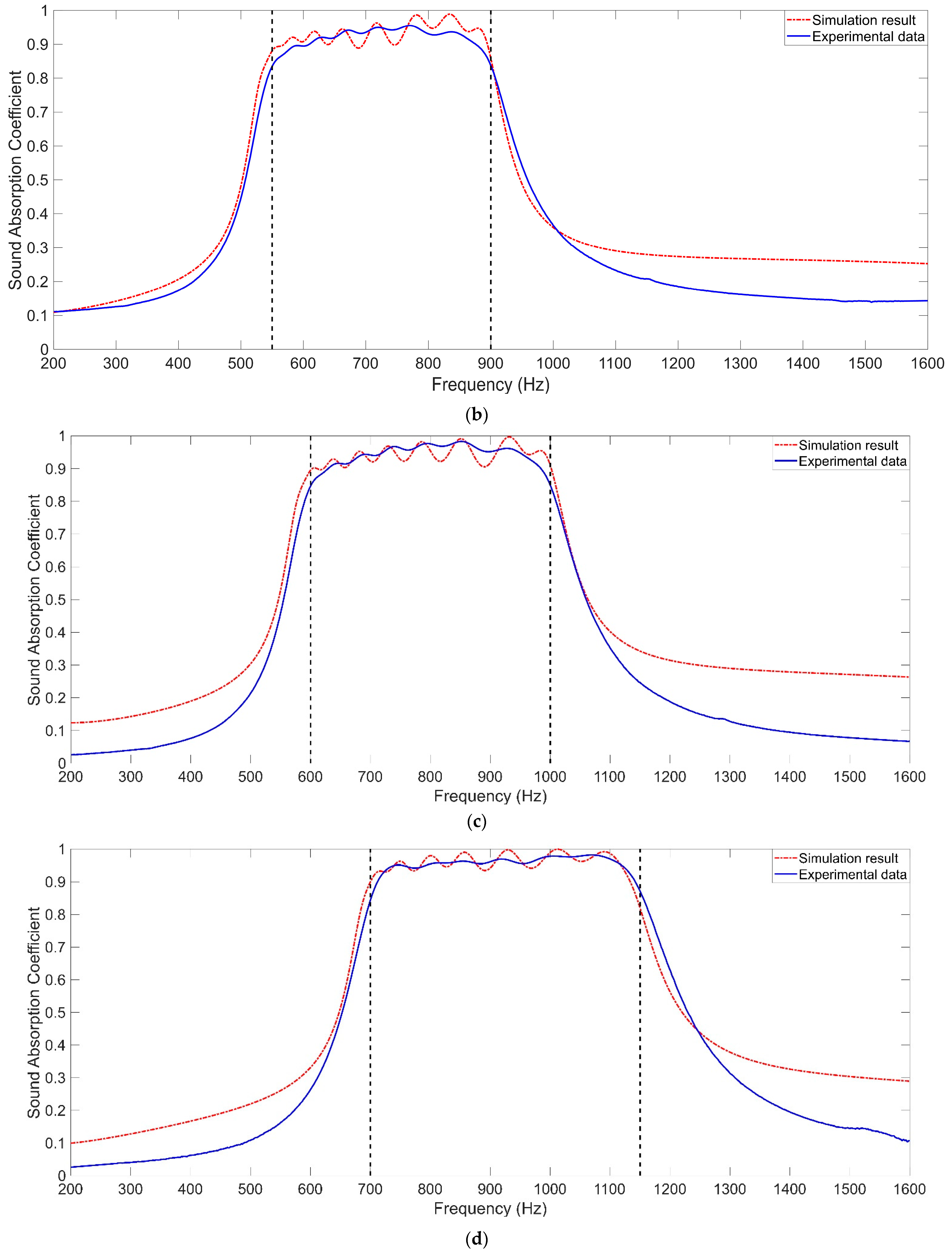
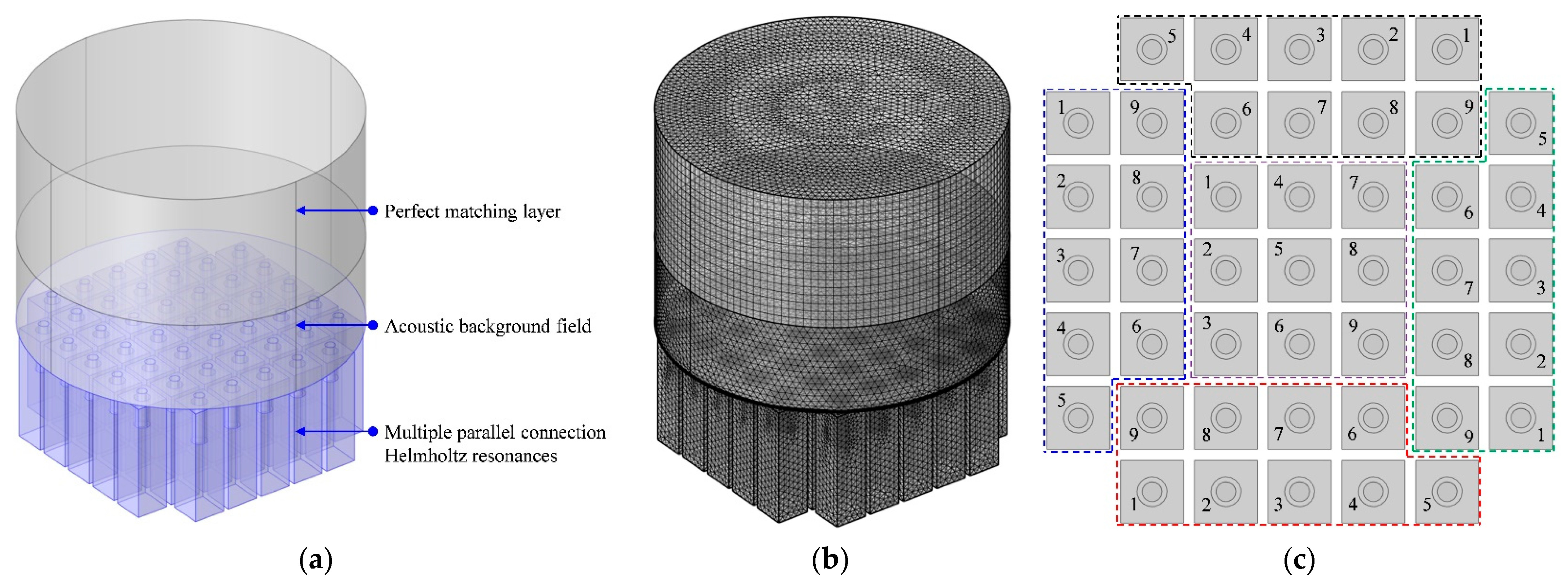
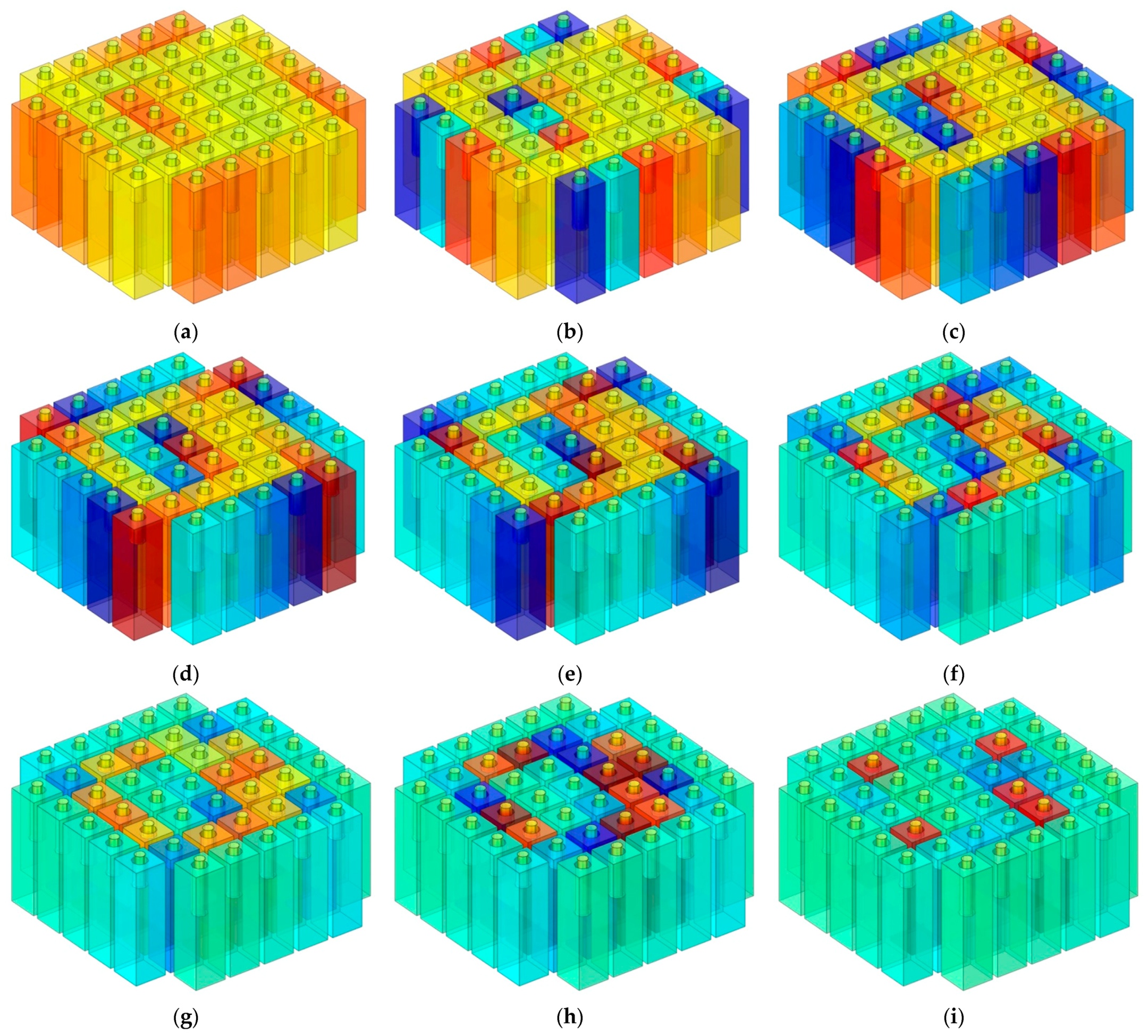
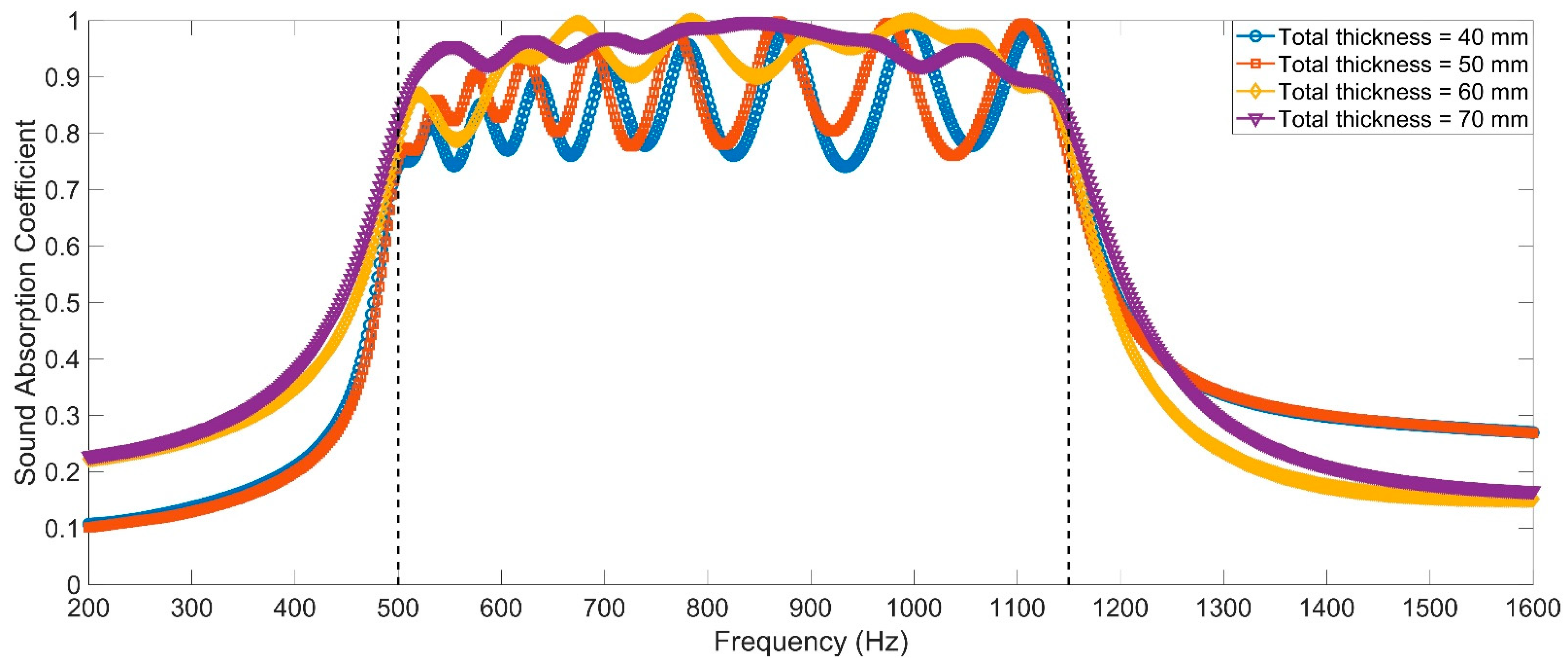
| Parameters | Cavity | Front/Back Panel | Side Wall | Aperture | |||
|---|---|---|---|---|---|---|---|
| Side Length a | Length T | Thickness t0 | Thickness t1 | Diameter d | Length l0 | Thickness t2 | |
| Values | 10 | 36 | 2 | 1.8 | 3.16 | 6 | 0.02 |
| Target Frequency Range | Length of the Aperture li (mm) | α(f) | ||||||||||
|---|---|---|---|---|---|---|---|---|---|---|---|---|
| l1 | l2 | l3 | l4 | l5 | l6 | l7 | l8 | l9 | Average | Maximum | Minimum | |
| 500–800 Hz | 25.7 | 23.9 | 21.7 | 18.6 | 16.1 | 13.4 | 10.8 | 8.6 | 7.4 | 0.9203 | 0.9539 | 0.8715 |
| 550–900 Hz | 21.2 | 19.2 | 17.0 | 14.7 | 12.3 | 10.0 | 7.9 | 6.4 | 5.3 | 0.9202 | 0.9552 | 0.8348 |
| 600–1000 Hz | 17.2 | 15.6 | 13.6 | 11.5 | 9.6 | 7.8 | 6.1 | 4.5 | 3.6 | 0.9436 | 0.9832 | 0.8474 |
| 700–1150 Hz | 11.2 | 10.3 | 9.0 | 7.5 | 6.1 | 4.7 | 3.4 | 2.2 | 2.0 | 0.9561 | 0.9817 | 0.8449 |
| Total Thickness (mm) | Diameter of the Aperture (mm) | Length of the Aperture li (mm) | α(f) | ||||||||||
|---|---|---|---|---|---|---|---|---|---|---|---|---|---|
| l1 | l2 | l3 | l4 | l5 | l6 | l7 | l8 | l9 | Average | Maximum | Minimum | ||
| 40 | 3.16 | 25.3 | 21.7 | 17.6 | 14.1 | 10.9 | 8.2 | 5.8 | 3.7 | 2.2 | 0.8421 | 0.9961 | 0.7412 |
| 50 | 3.16 | 20.9 | 17.5 | 14.4 | 11.4 | 8.5 | 5.9 | 3.7 | 2 | 0.6 | 0.8693 | 0.9987 | 0.7542 |
| 60 | 4.28 | 28.2 | 24.1 | 20 | 16 | 12.1 | 8.2 | 4.7 | 1.6 | 0.1 | 0.8926 | 0.9546 | 0.7509 |
| 70 | 5.44 | 35.8 | 29.7 | 23.8 | 18.3 | 13.3 | 8.7 | 4.9 | 1.9 | 0.1 | 0.9119 | 0.9541 | 0.7885 |
| 80 | 6.62 | 38.7 | 32.6 | 26.6 | 20.7 | 14.9 | 9.7 | 5.4 | 1.9 | 0.1 | 0.9229 | 0.9753 | 0.8496 |
Publisher’s Note: MDPI stays neutral with regard to jurisdictional claims in published maps and institutional affiliations. |
© 2022 by the authors. Licensee MDPI, Basel, Switzerland. This article is an open access article distributed under the terms and conditions of the Creative Commons Attribution (CC BY) license (https://creativecommons.org/licenses/by/4.0/).
Share and Cite
Yang, F.; Bi, S.; Shen, X.; Li, Z.; Zhang, X.; Wang, E.; Yang, X.; Peng, W.; Huang, C.; Liang, P.; et al. Adjustable Sound Absorber of Multiple Parallel-Connection Helmholtz Resonators with Tunable Apertures Prepared by Low-Force Stereolithography of Photopolymer Resin. Polymers 2022, 14, 5434. https://doi.org/10.3390/polym14245434
Yang F, Bi S, Shen X, Li Z, Zhang X, Wang E, Yang X, Peng W, Huang C, Liang P, et al. Adjustable Sound Absorber of Multiple Parallel-Connection Helmholtz Resonators with Tunable Apertures Prepared by Low-Force Stereolithography of Photopolymer Resin. Polymers. 2022; 14(24):5434. https://doi.org/10.3390/polym14245434
Chicago/Turabian StyleYang, Fei, Shaohua Bi, Xinmin Shen, Zhizhong Li, Xiangpo Zhang, Enshuai Wang, Xiaocui Yang, Wenqiang Peng, Changchuang Huang, Peng Liang, and et al. 2022. "Adjustable Sound Absorber of Multiple Parallel-Connection Helmholtz Resonators with Tunable Apertures Prepared by Low-Force Stereolithography of Photopolymer Resin" Polymers 14, no. 24: 5434. https://doi.org/10.3390/polym14245434
APA StyleYang, F., Bi, S., Shen, X., Li, Z., Zhang, X., Wang, E., Yang, X., Peng, W., Huang, C., Liang, P., & Sun, G. (2022). Adjustable Sound Absorber of Multiple Parallel-Connection Helmholtz Resonators with Tunable Apertures Prepared by Low-Force Stereolithography of Photopolymer Resin. Polymers, 14(24), 5434. https://doi.org/10.3390/polym14245434








